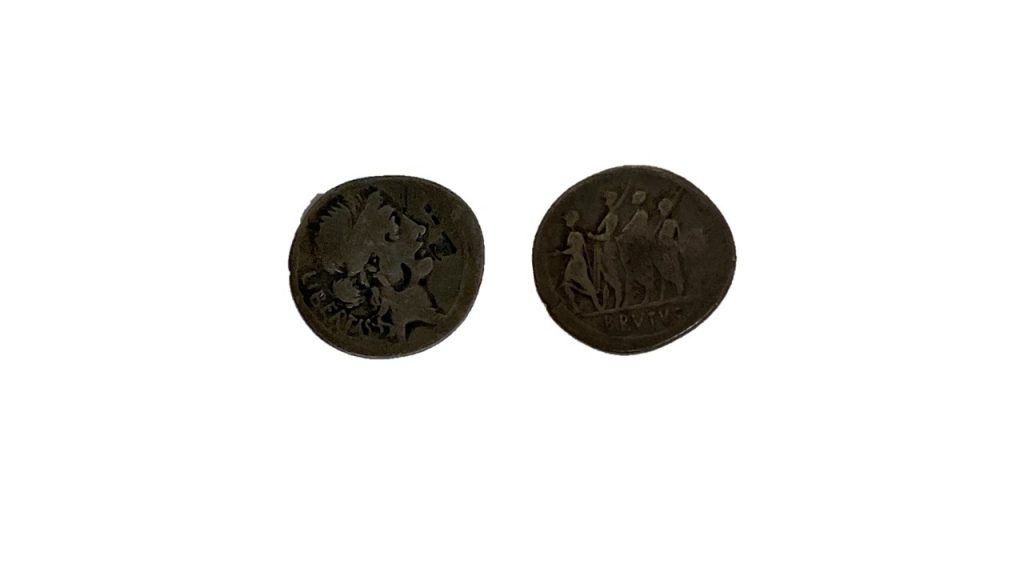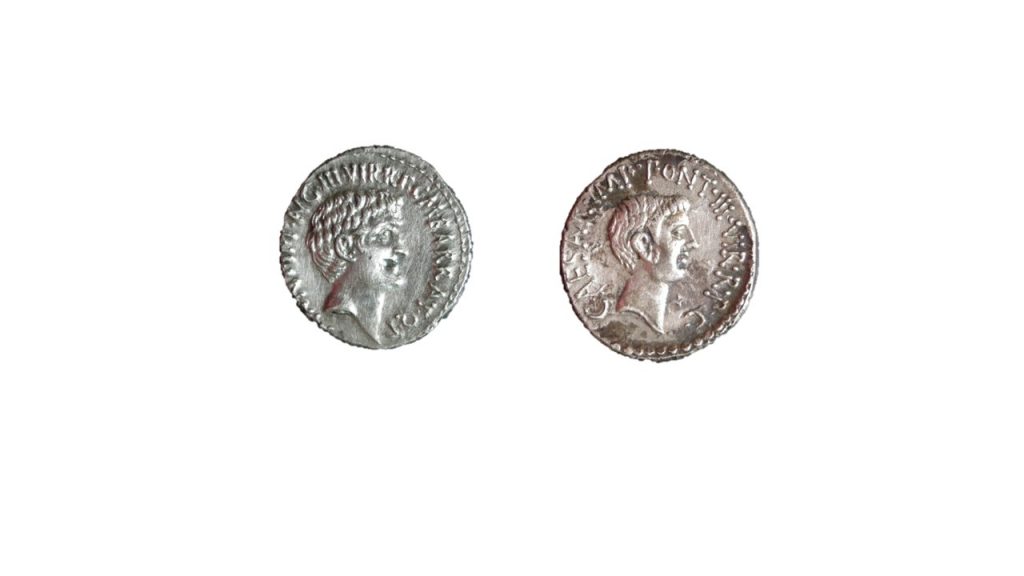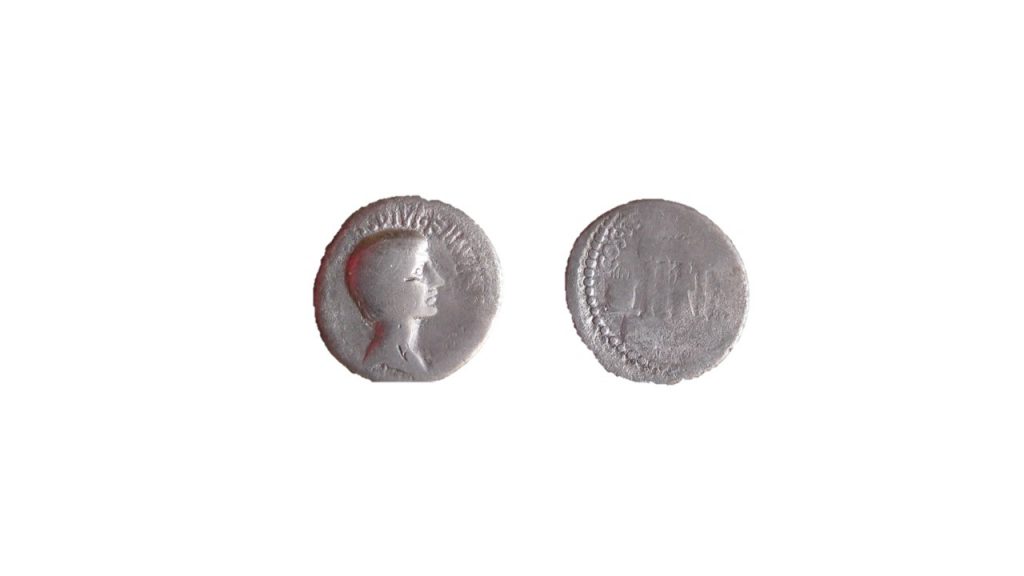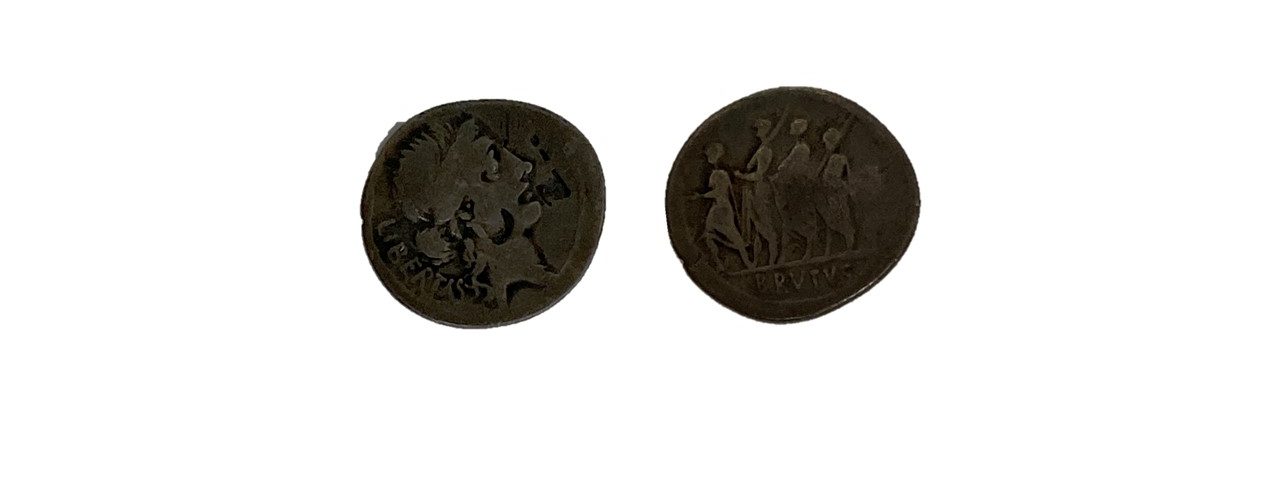Blog by Oliver Turney
Two thousand and sixty-six years ago, in 44 BC, on the 15th day of March, the life of Julius Caesar, immortalised in literature and popular culture from his own time to ours, was brought to an end.
Ruthless and violent, twenty-three stab wounds were inflicted upon his body, the blows delivered by some of his most trusted and closest friends. “Et tu, Brute?” (“Even you, Brutus?”, elsewhere suggested by Suetonius as, “You too, my son?”), Caesar’s famous last words according to William Shakespeare’s play about our murdered protagonist. These words were addressed to Decimus Junius Brutus, a close friend of Caesar (so close in fact that he was supposedly named as a second heir in Caesar’s will) and, it has been suggested in some quarters, his illegitimate son. Speculation on his parentage aside, his inclusion in the plot on Caesar’s life demonstrates the proximity of the assassins to Caesar – there was clearly discontent in Rome.

Coins minted by Marcus Brutus, refer to the violence of the “Ides of March”, with the inscription EID MAR being flanked by daggers – the weapons surreptitiously hidden beneath the togas of the murderers as they sat in attendance at a meeting of the senate on that day. Incidentally, that meeting of the senate was held in the Theatre of Pompey, Caesar’s past colleague, ally and later enemy – the civil wars of several years earlier (initiated after Caesar’s infamous crossing of the Rubicon River in 49 BC) saw these two illustrious generals pitted against one another, with Caesar ultimately emerging victorious. It was upon the statue of Pompey that he fell down dead, supposedly covering his head with his purple toga to prevent the world from seeing the demise of the “dictator”. Yes, it is true, Caesar’s title was that of Dictator. Contrary to the modern connotations of this word, the role of Dictator was different, with the dictatorial powers being more temporary, to be used in times of emergency. However, Caesar had been appointed Dictator Perpetuo – Dictator for Life – a title which, for the more traditional republican leading men of Rome, was unacceptable and unconstitutional.
Since the aforementioned Civil Wars between Pompey and Caesar at the start of the 40s BC, Caesar had been the leading man in Rome, bringing in many populist reforms, beneficial to the Roman people – reorganising the calendar into something we would vaguely recognise today, starting extensive building works, executing land reforms for his veterans (who had fought with him in Gaul in the 50s BC and in the civil wars) and creating a relatively stable political scene in Rome. This, however, would not last. While, for the people of Rome, this was a relatively positive time, the same cannot be said for the senatorial class. Caesar became increasingly more powerful during these years, alarmingly so, and this, paired with his growing arrogance and dismissiveness towards the senate, caused cogs of plot and revolution to begin to turn within the senators’ heads – the worry was that he was vying to become king (a fear fuelled by Marcus Antonius (better-known as Mark Antony) placing a diadem on his head at the Lupercalia Festival in February 44 BC). The idea of a monarchy was the antithesis of the republicanism supported by many senators – the whole principal of the Roman republic was to remove monarchs from Rome and sustain a stable form of government. Caesar was beginning to tear this to shreds.
Thus, with feelings of dissent brewing among senators, leading conspirators Marcus Junius Brutus (yes, another Brutus, just to make it more complicated!) and Cassius Longinus (a senator and general) started to amass a following for their cause in the weeks leading up to that fateful day. Interestingly, Brutus claimed to be descended from the man who had helped to remove the kings from Rome centuries before, Lucius Junius Brutus – so it seems that removing over-mighty leaders was in his blood! A coin minted in 54 BC by this Marcus Brutus can be found in the Corinium museum and it sees him harking back to his descendant, who brought LIBERTAS (emblazoned on the coin) to the Roman people, he clearly wanted to do the same.
This tyrannicide then was clearly methodically planned, and is described vividly in ancient sources – Caesar arriving late to the senate, Gaius Trebonius distracting Marcus Antonius outside the senate meeting so that Caesar walked in alone, senators crowding around Caesar, Tillius Cimber pulling Caesar’s toga, Casca delivering the first blow and a torrent of dagger thrusts from the other conspirators following that first incision. Despite initially struggling, Caesar stopped resisting and groaned when he saw his trusted friend Decimus Brutus stepping in to stab him. Falling at the feet of the statue of his old enemy Pompey, with his toga pulled over his head to prevent the assassins from seeing his dying face, Caesar succumbed to his wounds.

The conspirators, or as they labelled themselves “Liberators”, fled the scene and confusion and fear then reigned in Rome. What would follow in the years after the murder of Caesar was more civil war and political unrest which culminated in Octavian, Caesar’s heir, becoming the first emperor, Augustus, beating off Marcus Antonius in the process. Ironically Octavian and Antonius had previously been allies – a coin in the Corinium museum from after the death of Caesar (43-37 BC) with their faces on both sides reflects this unity, which would soon fall apart – again showing the changeable nature of alliances in ancient Rome. This step from a Republic to an Empire may seem to be radical, and it was certainly a huge shift, but the fact that Julius Caesar had already ascended to the role of Dictator Perpetuo, making him effectively the First Man in Rome, demonstrated that sole-leadership was not impossible, and from that it was not such a great leap to “emperor”.

The best indicator of Caesar’s importance to later Imperial Rome is the way that Octavian (Augustus) used his links to his adoptive father to further his own power and auctoritas (authority). The words DIVI FILIUS appear as part of Augustus’ official title and can be seen on his coins (which can be found also in Corinium Museum), reminding everybody that he was the son of a god (Caesar was posthumously deified). It is also no coincidence that later emperors included “Caesar” as part of their title and on their coins. Terms synonymous with power, like Tsar and Kaiser are even translations of the name Caesar – the powerful connotations of his name are clear! Therefore, the influence of Julius Caesar cannot be overstated and this day, the Ides of March, should not be forgotten.
So, over two thousand years ago, the western world was changed forever. Forever immortalised in literature and popular culture, the Ides of March should, and hopefully will, remain.
References:
Plutarch Lives, Volume Six. Translated by Bernadotte Perrin. Cambridge: Harvard University Press, 1919. Loeb Classical Library.
Scullard, H.H. From the Gracchi to Nero: A history of Rome 133 BC to AD 68. London: Routledge, 2011
Suetonius. The Twelve Caesars. Translated by Robert Graves. London: Penguin, 1957
Syme, Ronald. The Roman Revolution. Clarendon: Oxford University Press, 1939










